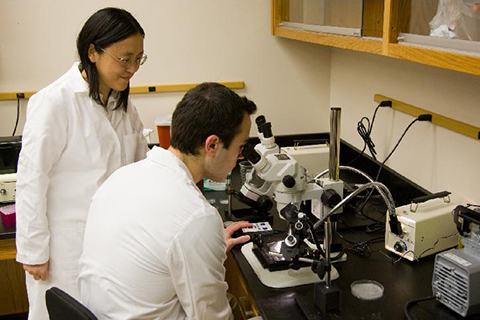- Biological Sciences
- News
Department of Biological Sciences
Dodge Hall Rm 375
118 Library Dr
Rochester,
MI
48309-4479
(location map)
(248) 370-3550
fax: (248) 370-4225
[email protected]
Biology student, professor research how arsenic builds up in plant seeds

For the past several years, Zijuan Liu, Ph.D. and doctoral student Joseph McDermott, from Oakland University's Department of Biological Sciences, have been working on groundbreaking research that promises to stave off a major threat to the world’s food supply. They are collaborating with a team of scientists from China, Germany and the United States to discover how arsenic accumulates in plant seeds.
Arsenic is a toxin and carcinogen that is pervasive in food and water, endangering the health of tens of millions of people worldwide. While the process of how arsenic is taken into roots and shoots of plants is fairly well understood, little is known about how arsenic gets into seeds.
Understanding how arsenic is accumulated in seeds – such as rice grain – is of critical importance to global health. Rice is a staple food for more than half the world’s population. In China, for example, about 60 percent of daily dietary arsenic comes from rice consumption, as reported in the journal “Metallomics.” In the U.S., the average person consumes about 25 pounds of rice per year, according the U.S. Rice Producers Association.
Fortunately, Dr. Liu and the research team are making strides in finding out how arsenic builds up in plant seeds. As reported in the journal "Nature Plants," the researchers discovered that the plant "A. thaliana" uses transport systems for inositol, a type of sugar, to load arsenite, the toxic form of arsenic, into seeds.
According to Dr. Liu, this is the first identification of transporters responsible for arsenic accumulation in seeds. The discovery could lead to far-reaching breakthroughs in protecting the world’s food supply, she says.
“If this same pathway of how arsenic accumulates also exists in rice, it will lead to the generation of new rice cultivators with less arsenic in the grain, a major advance toward minimizing the global health risks posed by arsenic in rice, and possibly in the near future, in other food sources,” Dr. Liu said.
As the research team continues to make progress, Dr. Liu is proud of her collaboration with McDermott, who was an undergraduate student when the work began.
“I put a lot of faith in undergraduate student research,” Dr. Liu said. “This result indicates our school has run a successful program to attract students who are interested in research.”
To learn more about Oakland’s Department of Biological Sciences, visit oakland.edu/biology.



